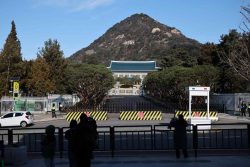
SpaceX’s Starship rocket prototype is pictured in the rocket launch area in Brownsville, Texas, U.S., May 12, 2024.
17:39 JST, June 6, 2024
SpaceX’s giant Starship rocket is scheduled for a fourth test flight to space on Thursday with a tricky primary objective: survive a blazingly hot re-entry through Earth’s atmosphere, the violent phase where the rocket broke apart during its last attempt.
Starship, a two-stage rocket standing nearly 400 feet (122 meters) tall, is poised to launch from SpaceX’s rocket facilities in south Texas as early as 7 a.m. local time (1200 GMT) for the latest trial mission in the test-to-failure rocket development campaign of Elon Musk’s company.
Designed to be cheaper and more powerful than SpaceX’s workhorse Falcon 9 rocket, Starship represents the future of the company’s dominant satellite launch and astronaut business. It is due to be used by NASA in the next few years to land the first astronauts on the moon since 1972.
Each Starship rocket has made it farther in its testing objectives than previous tests before failing, either by blowing up or disintegrating in the atmosphere.
The rocket’s first launch in April 2023 exploded minutes after liftoff some 25 miles (40 km) above ground. During the next attempt in November, Starship reached space for the first time but exploded soon after.
In its most recent flight in March, Starship made it much farther and broke apart in Earth’s atmosphere as it attempted to return from space halfway around the globe.
The rocket’s flight on Thursday will be a repeat of its previous test but with the aim to get farther. The rocket system’s first stage, called Super Heavy, is set to ignite its 33 Raptor engines to lift off, then separate from the Starship second stage, which would then blast further into space.
Super Heavy is expected to re-ignite some engines and return toward the Gulf of Mexico for a “soft splash-down” to simulate a landing that would otherwise be on land.
Meanwhile in space, Starship is expected to trek around the globe heading for the Indian Ocean to make a second attempt to survive the intense heat of atmospheric re-entry – the crucial point at which it failed in March.
The rocket is covered with hundreds of small black tiles designed to protect against the extreme heat encountered while diving through Earth’s atmosphere at hypersonic speeds.
“The main goal of this mission is to get much deeper into the atmosphere during reentry, ideally through max heating,” Musk, CEO of SpaceX, wrote on social media on Saturday.
Much is riding on SpaceX’s development of Starship, relied upon by NASA as it aims to return astronauts to the moon in 2026 in a rivalry with China, which plans to send its astronauts there by 2030. China has made several recent advances in its lunar program, including a second landing on the moon’s far side in a sample retrieval mission.
Despite Starship’s development appearing quicker than other rocket programs, it has been slower than Musk originally envisioned. A Japanese billionaire who initially paid to fly Starship around the moon canceled his flight last week, citing schedule uncertainties.
And Musk’s drive to rapidly build Starship has endangered SpaceX workers in Texas and California, a Reuters investigation found.
"News Services" POPULAR ARTICLE
-

American Playwright Jeremy O. Harris Arrested in Japan on Alleged Drug Smuggling
-

Japan’s Nikkei Stock Average as JGB Yields, Yen Rise on Rate-Hike Bets
-

Japan’s Nikkei Stock Average Licks Wounds after Selloff Sparked by BOJ Hike Bets (UPDATE 1)
-

Japan’s Nikkei Stock Average Buoyed by Stable Yen; SoftBank’s Slide Caps Gains (UPDATE 1)
-

Japanese Bond Yields Zoom, Stocks Slide as Rate Hike Looms
JN ACCESS RANKING
-

Keidanren Chairman Yoshinobu Tsutsui Visits Kashiwazaki-Kariwa Nuclear Power Plant; Inspects New Emergency Safety System
-

Tokyo Economic Security Forum to Hold Inaugural Meeting Amid Tense Global Environment
-

Imports of Rare Earths from China Facing Delays, May Be Caused by Deterioration of Japan-China Relations
-

University of Tokyo Professor Discusses Japanese Economic Security in Interview Ahead of Forum
-

Japan Pulls out of Vietnam Nuclear Project, Complicating Hanoi’s Power Plans























